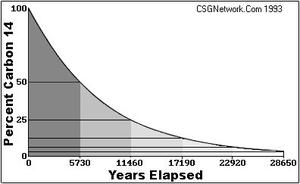Forensic technologyIdentifying disaster victims: Looking at teeth to determine victims' age at time of death
In disasters which claim many victims as well as in an unsolved homicide case, looking at victims’ teeth to determine how old they were at the time of death would help in identifying them; age determination of unknown human bodies is important in the setting of a crime investigation or a mass disaster, because the age at death, birth date, and year of death, as well as gender, can guide investigators to the correct identity among a large number of possible matches

Graph showing the decay of Carbon-14 over time // Source: creighton.edu
In a large natural disaster, such as the Haitian earthquake earlier this year, or in an unsolved homicide case, knowing the birth date of an individual can guide forensic investigators to the correct identity among a large number of possible victims.
Livermore researcher Bruce Buchholz and colleagues at the Karolinska Institute are looking at victim’s teeth to determine how old they are at the time of death. Using the Lawrence Livermore’s Center for Accelerator Mass Spectrometry, Buchholz determined that the radioactive carbon-14 produced by above-ground nuclear testing in the 1950s and 1960s remains in the dental enamel, the hardest substance in the body. The radiocarbon analysis showed that dating the teeth with the carbon-14 method would estimate the birth date within one year.
Age determination of unknown human bodies is important in the setting of a crime investigation or a mass disaster, because the age at death, birth date, and year of death, as well as gender, can guide investigators to the correct identity among a large number of possible matches. “Traditional structural re-creation methods used by anthropologists to determine age are often imprecise,” Buchholz said. “Radiocarbon dating gives a clear idea of the individual’s birth date.”
Above ground testing of nuclear weapons during the cold war (1955–63) caused a surge in global levels of carbon-14 (14C), which has been carefully recorded over time. The radiocarbon technique determines the amount of 14C in tooth enamel. Scientists can relate the extensive atmospheric record for 14C to when the tooth was formed and calculate the age of the tooth and its owner.
“We show how combining these two methods also can assist in estimating the date of death of an unidentified victim,” Buchholz said. “This strategy can be of significant assistance in forensic casework involving identification of dead victims.”
In the study, 44 teeth from 41 individuals were analyzed using racemization (a chemical process in which one amino acid is converted to its counterpart) analysis of tooth crown dentin or radiocarbon analysis of enamel, and 10 of these were split and subjected to both radiocarbon and racemization analysis. Combined analysis showed that the two methods correlated well.
Carbon-14, or radiocarbon, is naturally produced by cosmic ray interactions with air and is present at low levels in the atmosphere and food. Although nuclear weapons testing was conducted at only a few locations, excess levels of 14C in the atmosphere rapidly dispersed and equalized around the globe.
Since 1963, as a result of a worldwide test ban treaty, 14C levels in the atmosphere have been decreasing exponentially with a mean half-life of 16 years. Carbon-14 levels have not decreased because of radioactive decay (14C has a half-life of 5,730 years), but rather 14C has moved out of the atmosphere due to mixing with large marine and terrestrial carbon reservoirs. “Because radiocarbon is incorporated into all living things, this bomb curve forms a chronometer of the past 60 years,” Buchholz said.
The research appears in the May issue of the journal Molecular & Cellular Proteomics and is highlighted in a special issue dedicated to forensics in the journal Surface and Interface Analysis.
